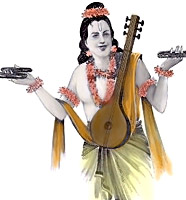 Lord Narad according to the great epic Mahabharata was the son of a Kashyap. His mother was one of the daughters of Daksha. He chants the name of Narayana. Narad carries a Tampura and uses it while singing hymns or prayers. He has a pointed knotted tuft of hair in the center of the scalp. He had invented Veena, the main stringed instrument of India and is deemed to be the leader of celestial musicians. The word `Narad` means the one who spread knowledge which is useful to the mankind. Among the Vaishnava followers he has an important position. It is said that he is one of the twelve great devotees of god.
Lord Narad according to the great epic Mahabharata was the son of a Kashyap. His mother was one of the daughters of Daksha. He chants the name of Narayana. Narad carries a Tampura and uses it while singing hymns or prayers. He has a pointed knotted tuft of hair in the center of the scalp. He had invented Veena, the main stringed instrument of India and is deemed to be the leader of celestial musicians. The word `Narad` means the one who spread knowledge which is useful to the mankind. Among the Vaishnava followers he has an important position. It is said that he is one of the twelve great devotees of god.
There are various legends regarding his birth. It is said that he sprang from the forehead of Brahma. Narad is represented as a wandering seer. He is known as the mischief-maker and his name is taken as a symbol of a person who is always creating a light mischief for Gods and Goddesses. Sage Narad is depicted as a travelling monk who has the ability to visit anywhere anytime and in any lace. He has appeared in Kreta, Treta and Dwapara Yugas. He is represented as a great worshipper of Lord Vishnu. He generally leads people to follow the path of spiritualism by engaging themselves in worship of Vishnu. Wherever he travelled he would try to bring in a spiritual and social change there which was considered as his advantage. He is also known by the names of triloka sanchaari, kalahapriya
He was well versed with the ancient texts of Vedas and Upanishads. He had mastered up the text of Samaveda which is dedicated to music. Narad was known for revealing secrets. This habit of his did create a trouble among Gods and Asuras though his intention was to promote a noble cause. He always invented plans to protecting the morally good and punishing the immoral.
There are not many temples dedicated to him in India. However there are two famous temples dedicated to him - Naraddev Temple in Madhya Pradesh and Narada Temple at Naradagadde in Karnataka.




















